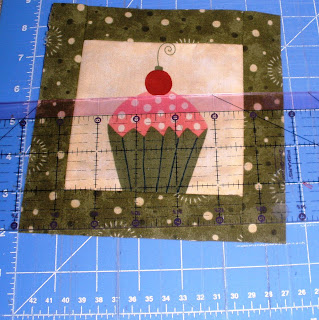Tracey wanted an idea for a quilt block, here's one that is never the same twice!
1. Take some freezer paper or butcher paper and cut it to the size you'd like to start out with for your block. Do remember, however, that because of seams and trimming the block will be smaller in the end.
- My block started out as 21 1/4" x 16 3/4"
2. Create your own cut lines on the paper (number of pieces should equal number of fabrics used). Don't do more than ten cuts/fabrics, or less than three.
- I have five fabrics and will make five pieces to cut out.
3. Cut each piece of fabric the size of your block.
4. Stack fabrics - a trick to keeping the fabrics from shifting when cutting is to run an iron over each one before stacking. Also, make a note of which fabrics are where if you are concerned you'll lose track of what is where!
5. Secure the paper on top of all of your fabrics; yes, you'll cut the paper too when you cut your fabrics. I used pins but you can also use weights or whatever else you can think of!
6. Cut through your lines. Below is an example of my first cut:
7. Now, in piece #1, move the 1st piece of fabric to the bottom; 2nd to the bottom; repeat that pattern until the last piece where you DO NOT SHUFFLE it AT ALL!
8. Sew all pieces together for each layer. A few things to remember: sew from the inside of the block towards the outside, & sew pieces together in descending order from your last cut. Ex: I made five pieces, so I sewed together 5 to 4, etc.
9. Iron sewn-together blocks separately.
10. Trim each square down to the smallest block size you have so they are all the same size.
11. Now you should have as many blocks as you did fabrics and they should all be different with like fabrics! This is a fun block to do because you can make up your own pattern and nothing ever turns out the same.
If you are interested in seeing more ideas on quilt blocks, I found this helpful website:






















































